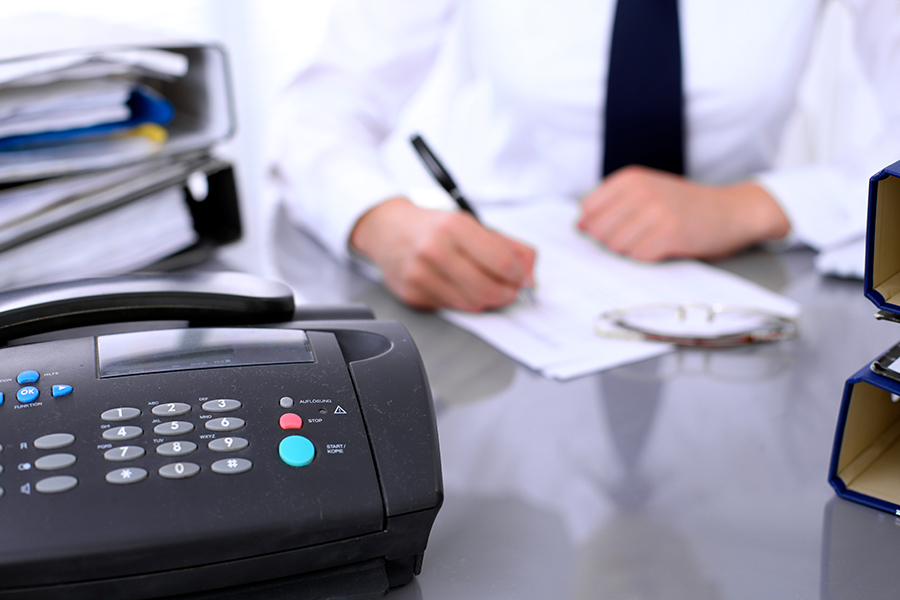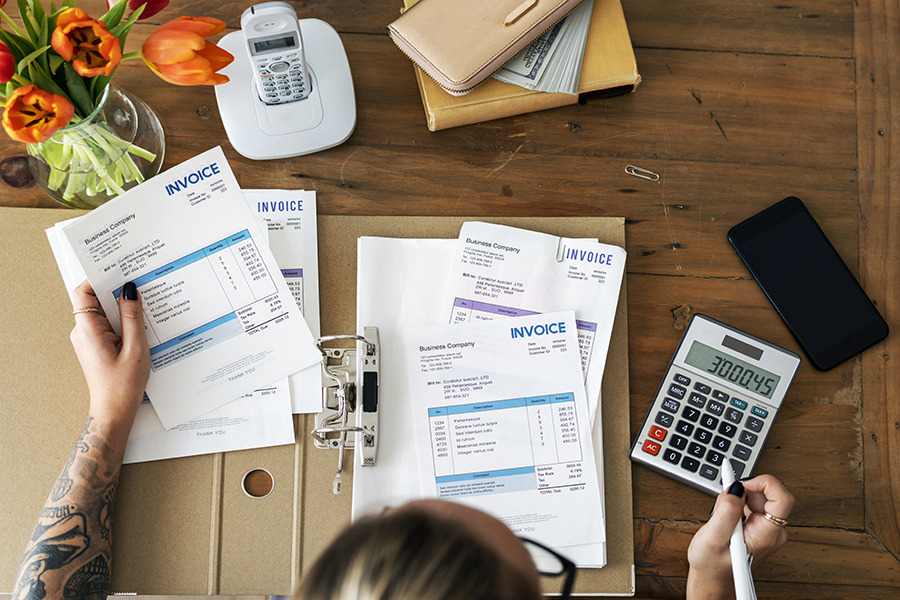People buy and sell their cars all the time. Therefore, a receipt is issued in car sale transactions as evidence of the sale. It benefits the seller by acting as proof of the sale and as evidence that they transferred the vehicle’s ownership to the buyer. Further, the seller can use it as proof of the agreed-upon purchase price when the buyer has not paid in full. It can also be proof of the car’s model, year of manufacture, and the terms of the agreement; for example, ‘the car was sold as is.’
What is a Car Sale Receipt
A car sale receipt is a document issued by a seller to a buyer as evidence of the sale of a car. It is a record of the sale transaction used for the private sale and purchase of vehicles from dealerships.
It will have a list containing the car, additional add-ons, sales tax, and excise taxes. The seller should only issue the receipt once the buyer has paid in full. It should be given along with the bill of sale, which is used to register the vehicle at the relevant Department of Motor Vehicles (DMV) office. Further, it can be used for security purposes in the future in case problems arise concerning the sale transaction.
The receipt will include:
- Vehicle details
- Buyer details
- Seller details
- Payment details (cash/check/other)
- Acknowledgment
Car Sale Receipt Templates
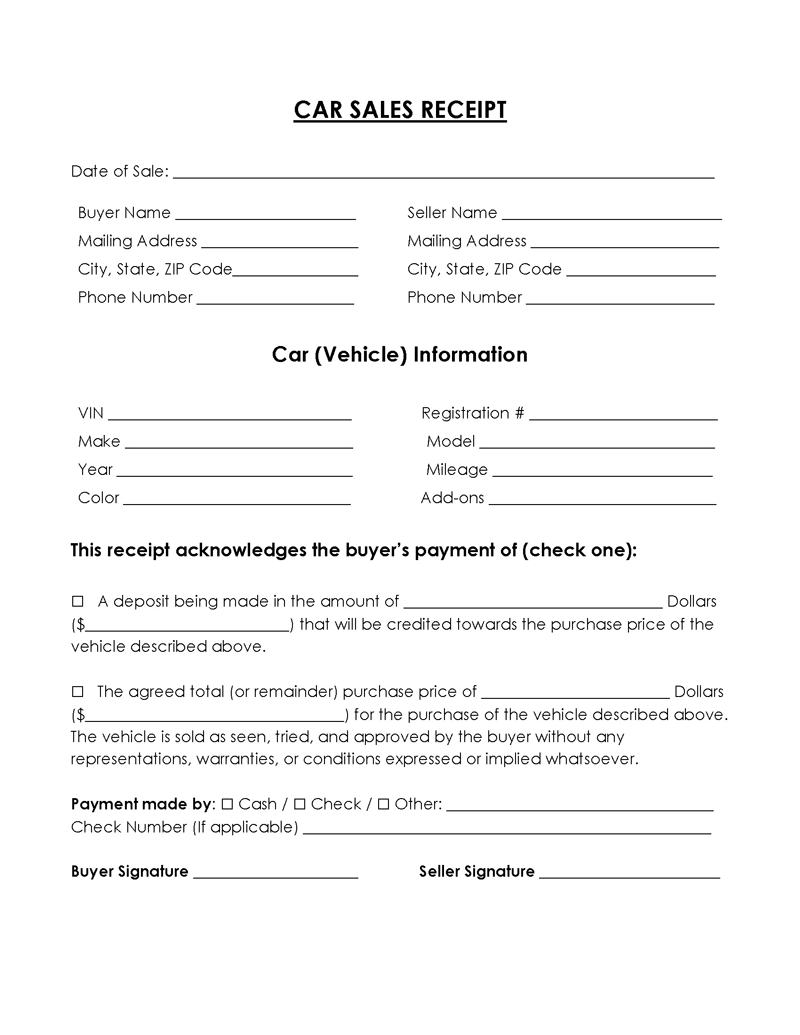
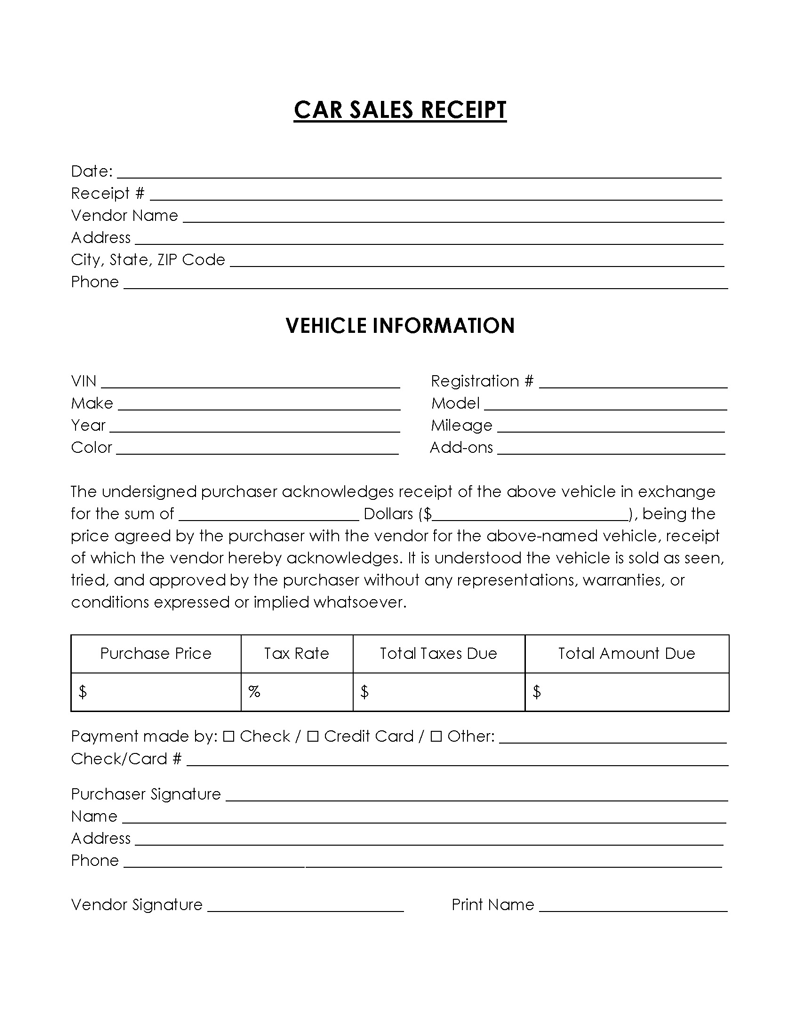
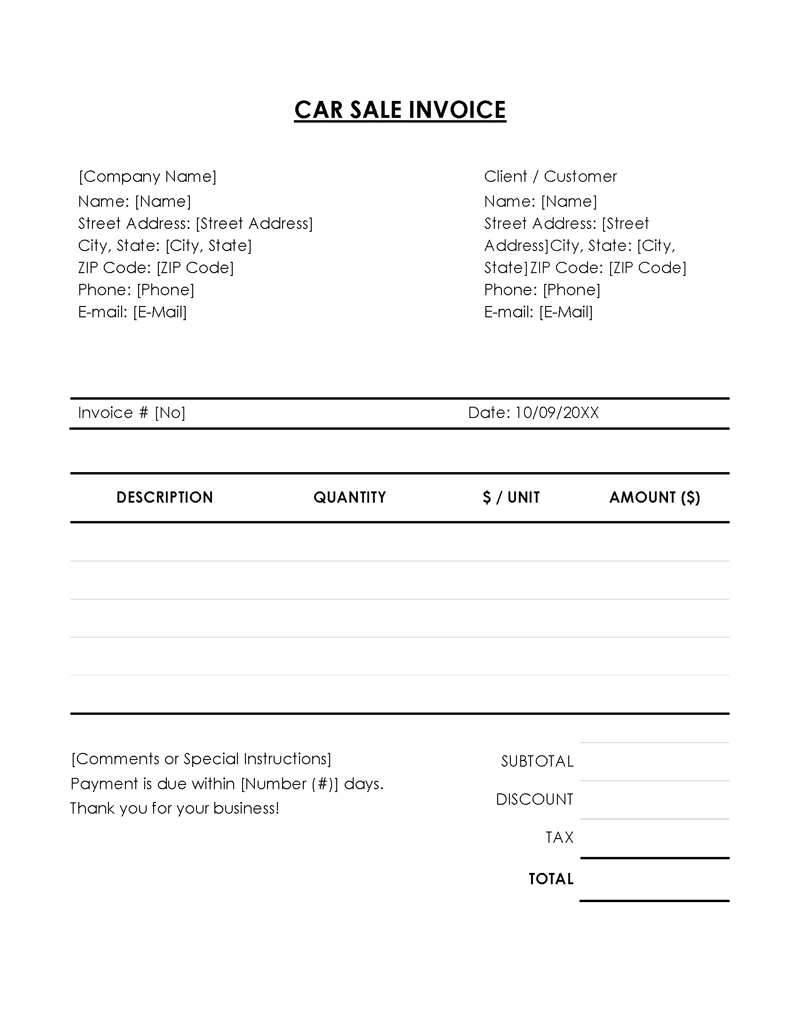
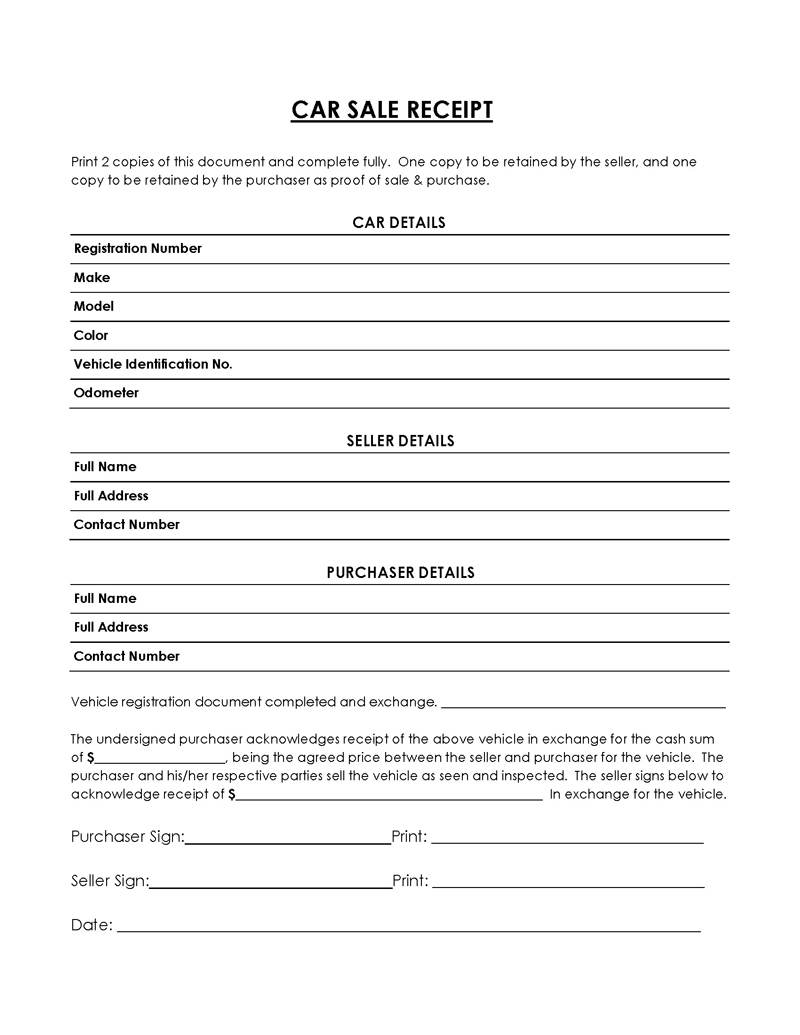
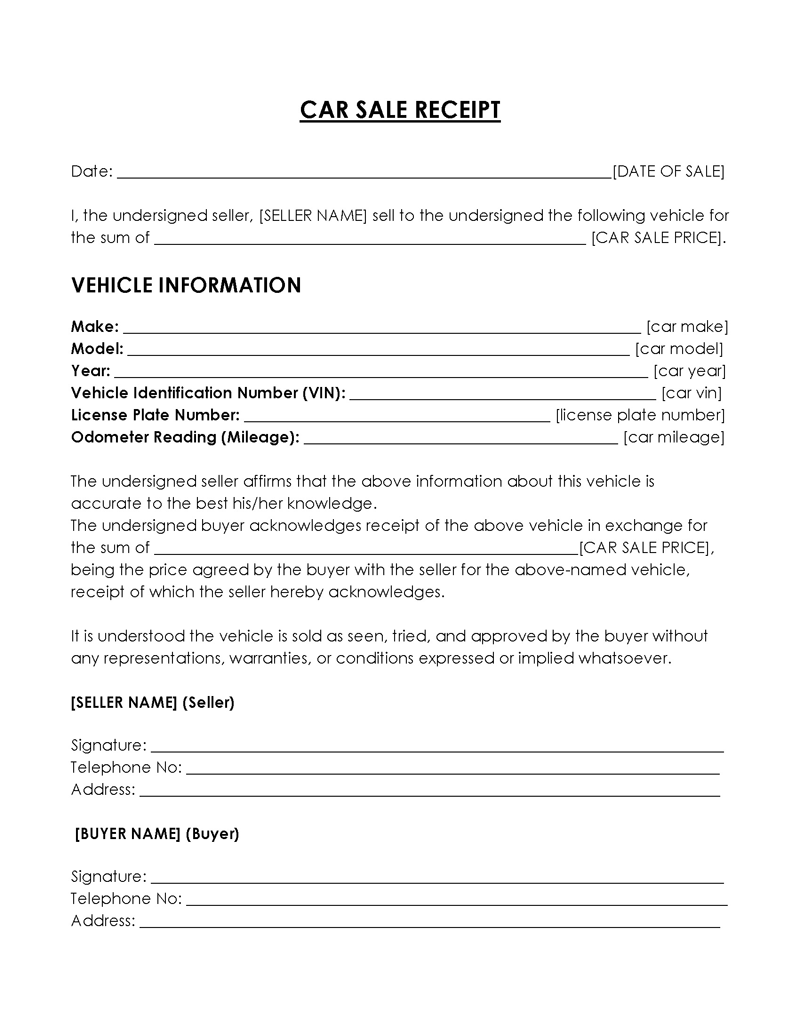
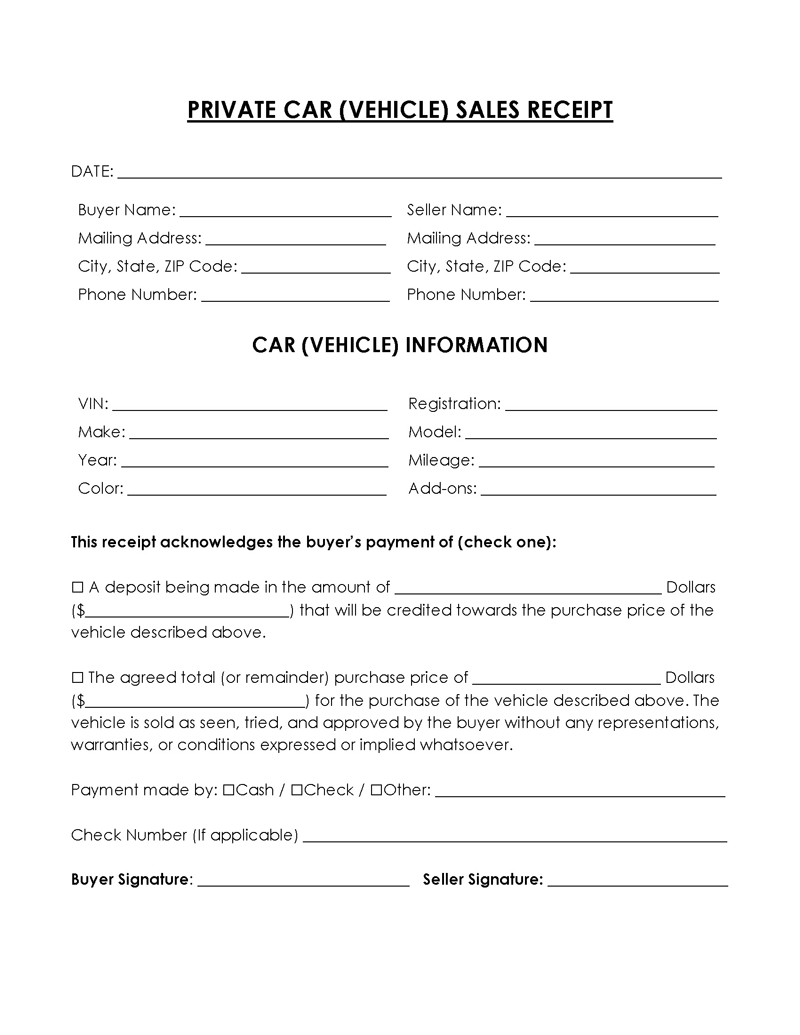
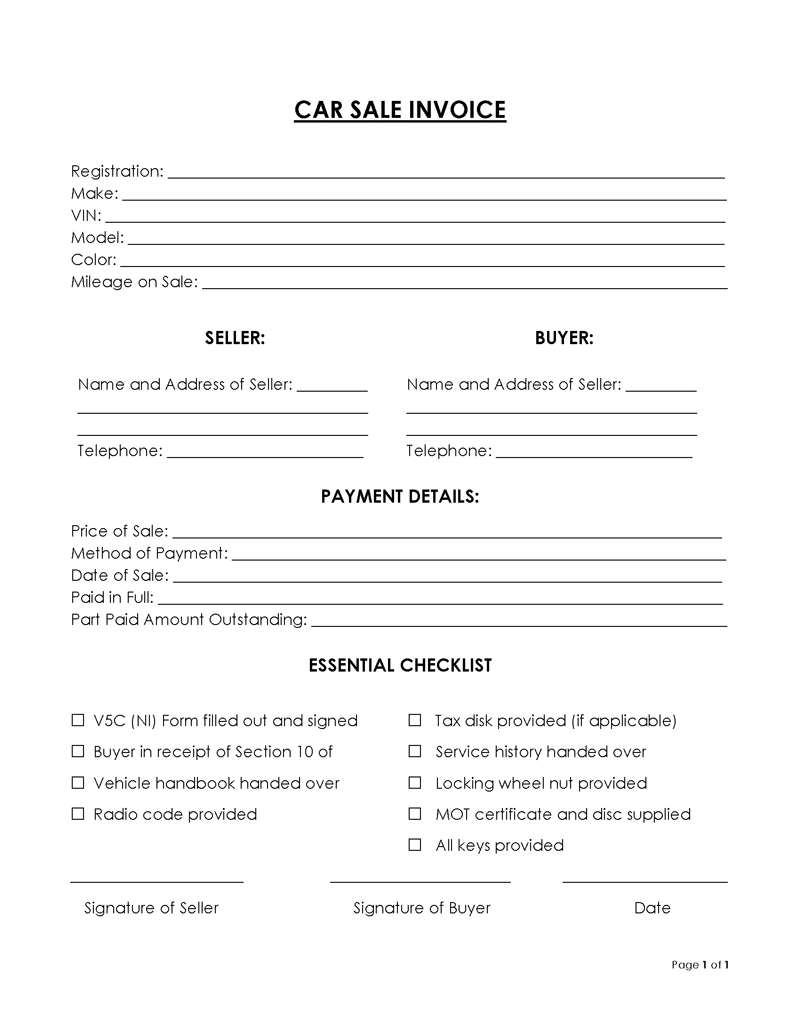
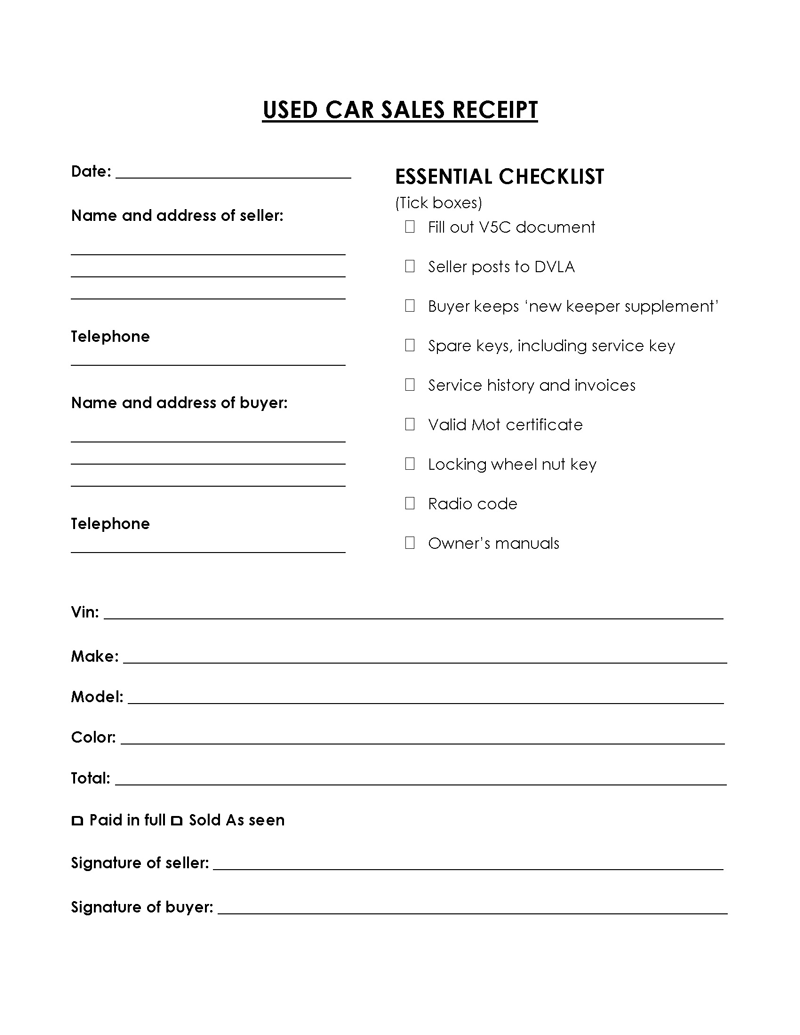
Information to Include in a Car Sale Receipt
A car sale receipt should prove the sale transaction between the buyer and seller. The information provided in the template should be accurate and conclusive. It is crucial to provide correct details of the vehicle, the buyer, and the seller, as this can be relied upon in case either party contests it.
Include the following information in it:
Date
It is vital to indicate the sale date. The date is usually the calendar month, day, and year on which the payment was fully received. It is stated right under the title of the receipt, as shown in the screenshot attached below. In some cases, the terms of the sale may permit the car’s return in circumstances where the seller has a policy that limits the return to seven days. In such an instance, it may be proof of the date of the purchase.

Receipt number
The seller indicates the receipt number according to their bookkeeping system. It comes right below the date. It helps the seller keep track of the sales over time. The number and other details allow the seller to identify the transaction among other transactions quickly. It is indicated after the date.

Seller’s information
The seller’s information is needed to identify the seller. The data is filled on the appropriate lines under the date (check the screenshot attached below). The seller’s name and address are also a way of verifying the authenticity of the seller and a physical location for record purposes..
Name – the seller should indicate their name on the blank line that is on the right side.
- Address: once the seller has identified themselves, they need to support their identity by showing how to contact them. As such, they should include their email address on the car sale receipt to make it easier for the customer to contact them whenever the need arises.
- City, state, zip code: the seller’s city, state, and zip code are an addition to the mailing address. They establish where the seller can be located physically.
- Phone number: the seller’s phone number is another means through which the seller can be reached. It shows the means of communication the seller maintains.

Vehicle information
The vehicle being sold needs to be sufficiently identified for the sake of the seller and the buyer. The information in this section should be concerning the vehicle’s outward appearance, such as its color, and internal details, such as its mileage, to make the receipt is effective. Further, the information provided expresses the buyer’s wants and preferences in a vehicle.
This section should be filled out in the following order to make it easy to read:
- VIN – the VIN is the vehicle’s identification number. It is a unique code used to identify the car being sold. It is indicated on the car sales receipt, as it can be used for insurance and registration checks.
- Make – the make of the car means the brand of the vehicle.
EXAMPLE
Lexus
While the VIN is like a fingerprint, the make of a car is indicated to show the vehicle’s distinguishing features.
- Year – the year of the car means the time the vehicle was manufactured. It is one factor a buyer considers when buying a car.
EXAMPLE
Older cars are less reliable and more likely to have problems than cars manufactured in recent years
Color–the color of a car is one of the considerations made by the buyer. By indicating the car’s color, the buyer and seller take a further step towards completing their sale transaction.
- Registration number–a vehicle’s registration number is significant because it is used to identify the vehicle in the state’s database. The registration number can be searched for the vehicle’s ownership details. The registration number is substantial because it allows the buyer to verify if the car they purchase will be free of liability.
- Model–a model is a name assigned to a car product in a range of other car products.
EXAMPLE
The Toyota company can produce a range of vehicles, including a Toyota Camry and a Toyota Lexus.
In this case, Camry and Lexus are the car models. The car model is important because it may dictate the price of the vehicle and its suitability for the buyer. Therefore, it is imperative to include the model of the car to ensure it is identifiable among others sold by the same seller.
- Mileage – the mileage of a vehicle is the distance that a car covers on one liter of fuel. The mileage is a way for both the buyer and seller to assess the car’s condition and is one of the factors used to determine the vehicle’s value.
All the above information is organized in two columns and should be filled in the appropriate blank spaces, as shown in the screenshot below.

Discuss the transaction
Once you have listed the vehicle’s details, the next step is to provide details of the transaction. The declaration paragraph contains an acknowledgement by the purchaser. The seller indicates the purchase price, first in words and then the amount in figures in brackets. The buyer states that they bought the vehicle at the agreed price.
The declaration paragraph is followed by a table indicating the purchase price, the tax rate, the total taxes due, and the total amount due. Because the taxes to be paid may be exclusive of the purchase price, the total amount due may be higher than the purchase price. The screenshot below gives a visual description of how each line should be filled.

Payment method
The method of payment comes after discussing the transaction. You will need to indicate the method of payment by which the payment was submitted. There are three checkboxes for this; check, credit card, or any other payment method. Input the number of the check or credit card used in the blank space appearing after the checkboxes for the payment method.

Buyer’s information
The buyer’s information is needed on the receipt to identify them as a party to the transaction. The buyer’s name and address are also a way of showing the buyer’s usual method of communication and physical location for records purposes.
- Name: the buyer’s name is indicated on the blank line after the word ‘name.’
- Address: once the buyer has identified themselves, they need to support their identity by showing how they can be contacted through various means of communication, such as the mailing address.
- City, state, and zip code: the buyer’s city, state, and zip code are an addition to the mailing address. They establish where the buyer can be located physically if the need arises.

Seller and buyer’s signature
After indicating the details of the seller, buyer, vehicle, and purchase price on the receipt, the buyer and the seller acknowledge its contents by appending their signatures. The buyer begins by signing their full name on the ‘purchaser signature line’ and then prints out their name, address, city, state, ZIP code, and telephone number where requested. Next, the seller shall sign in the ‘vendor signature’ line and print their name on the blank line after their signature. See the screenshot below for details on how the above information should be reported.

You can also include notes on dents, marks, or broken parts discovered or discussed. These notes should contain the final agreement of the buyer and seller regarding faults found, for example, whether the car was sold ‘as is’ or whether there were any repairs to be made and who would make payments for them. The receipt may also include a reminder of the date the vehicle was last serviced or the party responsible for payment of upcoming fees.
Factors to acknowledge in the sale receipt
Upon filling out the details of the seller, buyer, and vehicle, both the buyer and seller need to sign the receipt. The acknowledgment section is an acceptance by the buyer and the seller that the car has no fines owing, the seller is the legal owner of the car and has the authority to sell it, and the vehicle is free of liability due to a third party. Once both parties agree with the conditions above, they should sign the receipt as proof. Each party should then make a copy or, where applicable, retain the original document for documentation purposes.
Final Remarks
A car sales receipt is essential in the sales transaction. First, it proves that the buyer purchased the vehicle; hence its ownership changed. Second, it is proof that the seller received the purchase price for selling the car. Third, this receipt can be proof in the future if any statements are made contrary to the information received. In addition, to being a form of security, the car sales receipt is a record of the seller’s dealings and bookkeeping system.


